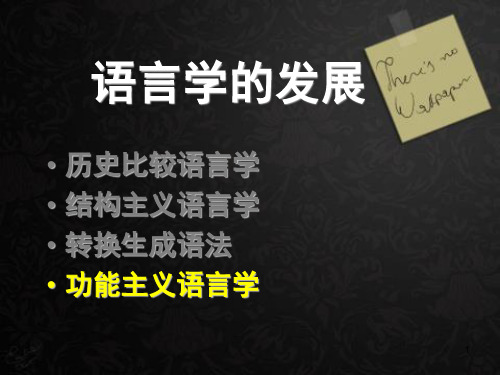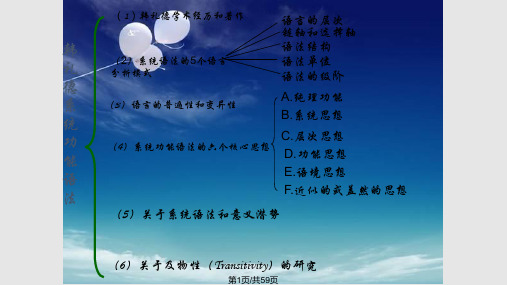系统功能语言学(二)PPT课件
合集下载
系统功能语言学-系统功能语言的应用

语篇衔接与连贯
系统功能语言学关注语篇的衔接 与连贯,翻译时需关注源语言和 目标语言在语篇结构、衔接手段 等方面的差异,确保译文的连贯 性和可读性。
实例分析:系统功能语言在翻译中的应用
实例一
在翻译科技文本时,系统功能语言学可指导译者分析原文 的语域特点,选择合适的词汇和句式,确保译文的准确性 和专业性。
语域理论
语域是语言使用的特定领域或范围, 如科技、法律、文学等。不同语域有 不同的词汇、语法和表达方式。语域 的选择受到语境的制约和影响。
03
系统功能语言在文本分析中的应用
文本类型与语域分析
文本类型识别
通过系统功能语言学理论,可以识别文本所属的类型,如新 闻、广告、科技论文等,进而针对不同类型文本进行有针对 性的分析。
语域特征提取
语域是指语言使用的特定领域或环境。通过系统功能语言学 的方法,可以提取文本中的语域特征,如专业术语、行业用 语等,从而深入了解文本所涉及的主题和领域。
文本中的衔接与连贯
衔接手段分析
衔接是文本中不同部分之间的连接关系。通过系统功能语言学理论,可以分析文本中使用的衔接手段,如指代、 省略、连接词等,进而探讨文本内部的逻辑关系。
对未来研究的展望
拓展系统功能语言学的 研究领域,探索其在更 多语言和文化背景下的 适用性和有效性。
加强系统功能语言学与 其他语言学分支的交叉 研究,促进语言学理论 的整合和发展。
推动系统功能语言学在 人工智能、自然语言处 理等领域的应用,为语 言科技的创新提供理论 支撑。
关注系统功能语言学在 解决社会问题中的应用 ,如语言与性别、语言 与权力等议题,发挥语 言学的社会价值。
概念功能
表达说话者对客观世界和主观 世界的经验,包括及物性系统 和语态系统。
功能主义语言学(课堂PPT)

料也不够完整齐全,制作的效 果未必能较好地达到。
望大家理解包涵!谢谢!
.
13
韩礼德
继承和发展了弗斯的理论,在对语
言的系统 和 结构进行充分研究的基础上
,从功能角度研究语言。着重探讨语言
的意义和功能,研究语言如何使用,分
析语言与社会的关系,以及语言功能与 语言系统的关系。
.
6
研究特点:
从功能的角度解释语言现 象。
研究目的:
论证语言功能决定语言形式 ,认为人们的语法知识主要来自后 天的经验。
以弗斯jrfirth为奠基人的伦敦功能结构语言学派认为语言的本质是意义语言环境中的意义语义是语言研究的中心主张从社会的角度去观察研究语言强调语言的社会性语言的本质功能是社会交际功能
语言学的发展
• 历史比较语言学 • 结构主义语言学 • 转换生成语法 • 功能主义语言学
.
1
功能主义语言学
Functional Linguistics
之后的欧洲学派的理论思想和研 究方法的概括。
从20世纪30年代起步到60年代发
展壮大,至今已广为应用到社会学、文 体学、翻译研究、文学批评和语言教学 等领域。
形式
功能
.
4
30年代布拉格学派
以弗斯(J.R.Firth)为奠基 人的伦敦功能结构语言学派认为 语言的本质是意义——语言环境 中的意义,语义是语言研究的中 心,主张从社会的角度去观察、 研究语言,强调语言的社会性, 语言的本质功能是. 社会交际功能。5
.
7
局限性:
强调了语言的功能性, 却相对忽视了语言的形式性。
.
8
现代语言学两大阵营
形式主义
> 功能主义
.
望大家理解包涵!谢谢!
.
13
韩礼德
继承和发展了弗斯的理论,在对语
言的系统 和 结构进行充分研究的基础上
,从功能角度研究语言。着重探讨语言
的意义和功能,研究语言如何使用,分
析语言与社会的关系,以及语言功能与 语言系统的关系。
.
6
研究特点:
从功能的角度解释语言现 象。
研究目的:
论证语言功能决定语言形式 ,认为人们的语法知识主要来自后 天的经验。
以弗斯jrfirth为奠基人的伦敦功能结构语言学派认为语言的本质是意义语言环境中的意义语义是语言研究的中心主张从社会的角度去观察研究语言强调语言的社会性语言的本质功能是社会交际功能
语言学的发展
• 历史比较语言学 • 结构主义语言学 • 转换生成语法 • 功能主义语言学
.
1
功能主义语言学
Functional Linguistics
之后的欧洲学派的理论思想和研 究方法的概括。
从20世纪30年代起步到60年代发
展壮大,至今已广为应用到社会学、文 体学、翻译研究、文学批评和语言教学 等领域。
形式
功能
.
4
30年代布拉格学派
以弗斯(J.R.Firth)为奠基 人的伦敦功能结构语言学派认为 语言的本质是意义——语言环境 中的意义,语义是语言研究的中 心,主张从社会的角度去观察、 研究语言,强调语言的社会性, 语言的本质功能是. 社会交际功能。5
.
7
局限性:
强调了语言的功能性, 却相对忽视了语言的形式性。
.
8
现代语言学两大阵营
形式主义
> 功能主义
.
功能语言学导论PPT

05
功能语言学面临的挑战与展望
语言变异与变化的挑战
语言变异
随着社会、文化和技术的不断发展,语 言也在不断变化和演化。功能语言学面 临着如何有效描述和解释语言变异现象 的挑战。
VS
语言变化
语言的变化是一个持续不断的过程,功能 语言学需要关注并研究语言变化的趋势和 规律,以适应和应对这种变化。
跨文化交际的挑战
功能语言学的历史与发展
Hale Waihona Puke 历史功能语言学起源于20世纪初,随着社 会语言学、语用学、文化语言学等学 科的发展,功能语言学逐渐形成并发 展壮大。
发展
功能语言学的发展经历了多个阶段, 包括布拉格学派、哥本哈根学派、伦 敦学派等,这些学派都对功能语言学 的发展做出了重要贡献。
功能语言学的应用领域
跨文化交际
要点一
技术发展
随着新技术的不断发展,语言的表达和传播方式也在不断 变化。功能语言学需要关注新技术对语言的影响,并研究 如何利用新技术进行有效的语言研究和应用。
要点二
新媒体影响
新媒体的出现对语言的传播和使用方式产生了深刻影响, 功能语言学需要研究新媒体对语言的影响,并探讨如何利 用新媒体进行有效的语言传播和应用。
功能语言学的未来展望
跨学科融合
功能语言学需要与其他相关学科进行更深入 的融合,如心理学、社会学、计算机科学等 ,以拓展研究领域和应用范围。
人工智能与自然语言处理
随着人工智能和自然语言处理技术的不断发 展,功能语言学将更加深入地与这些技术相 结合,以实现更高效、智能的语言分析和应
用。
THANKS
感谢观看
话语分析在跨文化交际、文学 批评、媒体研究等领域有广泛 应用。
语用学
课件-语言学-第二章

语言结构的二层性是就语言系统的整体结构来说 的,而每一层、每一级的结构单位如何运转?组合 和聚合,这两条规则是驾驭语言系统运转的 “纲”;抓住了这条“纲”,我们也就能把握住 语言系统的结构脉络。
什么是组合规则(Combination rules)?就是构成 线符号的单位互相组合为一个更大单位的规则。 语言结构单位顺着时间的线条前后相续,组成上 一层或上一级的一个结构单位,好像一个个连接 在一起的链圈,一环扣一环,组成一根环环相扣 的链条。
组成五六千个语素的语音表达形式,五六千个语 素可以组成几十万个词(大型英语词典大致收词四 十余万条),而这几十万条词则可以组成无穷无尽 的句子。语言为什么能够成为人们得心应手的交 际工具?语言系统的这种灵活的层级装置是一个重 要的原因,因为它为人们以少数驾驭多数奠定了 结构的基础。
二、组合关系与聚合关系(Combination relations and paradigmatic relations)
第二章 语言是符号系统 (linguistic sign system)
第一节 语言符号的性质和特点 第二节 语言符号的系统性 第三节 语言系统是人类特有的
第一节 语言符号的性质和特点
一、语言的符号性 (一)符号和语言符号
1、符号:是用甲事物来代替乙事物,是人们 约定的记号。(与征候不同)
符号是由形式和内容两部分构成的结合体,形式 是人的感觉器官可以感知的,内容则是形式所表 达的意义。
语言符号是音与义的结合体,因而音与义自然处 于最下层。语言符号的下层(底层)是一套音位 (Phoneme)。一种语言的音位是有限的,一般 只有三四十个,但这些有限的音位按照一定的规 则进行组合而构成语音(如上述的gang,bang之类), 基本上就能满足意义表达的需要,构成语言符号。
什么是组合规则(Combination rules)?就是构成 线符号的单位互相组合为一个更大单位的规则。 语言结构单位顺着时间的线条前后相续,组成上 一层或上一级的一个结构单位,好像一个个连接 在一起的链圈,一环扣一环,组成一根环环相扣 的链条。
组成五六千个语素的语音表达形式,五六千个语 素可以组成几十万个词(大型英语词典大致收词四 十余万条),而这几十万条词则可以组成无穷无尽 的句子。语言为什么能够成为人们得心应手的交 际工具?语言系统的这种灵活的层级装置是一个重 要的原因,因为它为人们以少数驾驭多数奠定了 结构的基础。
二、组合关系与聚合关系(Combination relations and paradigmatic relations)
第二章 语言是符号系统 (linguistic sign system)
第一节 语言符号的性质和特点 第二节 语言符号的系统性 第三节 语言系统是人类特有的
第一节 语言符号的性质和特点
一、语言的符号性 (一)符号和语言符号
1、符号:是用甲事物来代替乙事物,是人们 约定的记号。(与征候不同)
符号是由形式和内容两部分构成的结合体,形式 是人的感觉器官可以感知的,内容则是形式所表 达的意义。
语言符号是音与义的结合体,因而音与义自然处 于最下层。语言符号的下层(底层)是一套音位 (Phoneme)。一种语言的音位是有限的,一般 只有三四十个,但这些有限的音位按照一定的规 则进行组合而构成语音(如上述的gang,bang之类), 基本上就能满足意义表达的需要,构成语言符号。
系统功能语言句法研究PPT课件

another, or to some defined location.
3. Conflate an element or participant Role (b) ‘Conflate’ one element with another.
with an existing element
4. Expound an element by an item.
• Figure 5: the components and their outputs in a systemic functional grammar (Fawcett 2008:41)
18
意义潜势表现为意义特征的系统网络,具体实例为意义特征 的选择表达。潜势体现为体现规则和潜势结构,具体实例为 标注的树形结构。
基于成分结构,有几种与语言的三大元功能相联系的功能 结构:实现概念功能的及物性结构和在不同级阶上的复杂 结构;实现人际功能的语气结构;实现语篇功能的主位结 构和信息结构。
10
成分结构建立在级阶的基础之上。级阶成分分析法也叫“最少加括法”, “只在必须加注的地方标注括弧”,这与“最多加括法”即“直接成分分 析法”形成对比,它“在任何可能的地方标注括弧 (Halliday 1985: 22)”。 这可以通过图 3 清楚看出来。
当Halliday的语法被“远远推向意义一方”,形式在某种程 度上被忽视时,Morley的研究和Halliday的功能语法是互补 的 。 Morley 的 研 究 试 图 把 它 拉 回 原 有 的 基 础 , 所 以 他 与 Halliday选择了相反的方向:从形式到功能。从这个角度上, 它说明了“句法结构分析框架是如何反映语言的意义结构的 (Morley 2004: 2)”。
功能语言学简介 ppt课件

ppt课件
31
语言隐喻
语 法 隐 喻 ( Grammatical Metaphor ) 理 论 是 Halliday首次创立的(1985年前后),是系统功能语言 学 的 重 要 组 成 部 分 , 以 《 功 能 语 法 导 论 》(An Introduction to Functional Grammar)(1985)一书为 该理论正式诞生的标志。语法隐喻不同传统意义上的隐 喻。语法隐喻是与词汇隐喻相对立的而提出的。
Martinet认为尽管语言可以发挥表达、交际和 审美等多种功能,但交际功能才是语言的“中 心功能”,在语言研究的各个方面都应该贯穿 功能主义。
她 于 1967 年 首 先 创 造 “ 互 文 性 ” (intertextuality)这个术语,并把它引入文本 分析和文学批评。所谓“互文”(intertext) 指的是存在于其他语篇之间的语篇;所谓“互 文性”指的就是不同语篇之间的这种相互关系。
2.微观功能 microfunction
儿童语言有如下其中功能: (1) 工 具 instrumental 功 能 ;(2) 控 制 regulatory 功 能 ;(3) 交流功能interactional;(4)个体功能(personal); (5) 启 发 heuristic 功 能 ;(6) 想 象 imaginative 功 能 ;(7) 告 知 informative功能 。
欧洲功能主义 学派
P 布拉格学派
L
伦敦学派
C 哥本哈根学派
F
法国学派
H
荷兰学派
R 俄罗斯学派
ppt课件
8
布拉格学派
创
立
1926年捷克布拉格语言学小组的成立标志着布 拉格学派的诞生。
系统功能语言学ppt课件

// not argue with him. (R)
主位= don’t you
Ex: Don’t you (T) //worry. (R)
Don’t you (T) // open the door. (R)
8
经营者提供商品或者服务有欺诈行为 的,应 当按照 消费者 的要求 增加赔 偿其受 到的损 失,增 加赔偿 的金额 为消费 者购买 商品的 价款或 接受服 务的费 用
疑问句中 的主位
(2)特殊疑问句:主位= 疑问词 Ex: How (T) // did you do it? (R) Where (T) // has my little dog gone? (R)
(3)特殊情况:主位= 疑问句中的其他成分 Ex: After tea (T) // will you tell me a story? (R) In your house (T) // who does the cooking? (R)
主位与疑问句
如何划分疑问句的主位?
※ 夸克:
主位=动词的限定成分
※ 韩礼德
√
主位=动词的限定成分+主语
6
经营者提供商品或者服务有欺诈行为 的,应 当按照 消费者 的要求 增加赔 偿其受 到的损 失,增 加赔偿 的金额 为消费 者购买 商品的 价款或 接受服 务的费 用
(1)是非疑问句:主位= 动词的限定成分+主语 Ex: Can you (T) // lend me this book? (R) Is anybody (T) // there? (R)
(5)小句中的状语 Ex: On top of the hill (T) // stands an old Chinese
temple. (R) (6)小句中的其他成分
主位= don’t you
Ex: Don’t you (T) //worry. (R)
Don’t you (T) // open the door. (R)
8
经营者提供商品或者服务有欺诈行为 的,应 当按照 消费者 的要求 增加赔 偿其受 到的损 失,增 加赔偿 的金额 为消费 者购买 商品的 价款或 接受服 务的费 用
疑问句中 的主位
(2)特殊疑问句:主位= 疑问词 Ex: How (T) // did you do it? (R) Where (T) // has my little dog gone? (R)
(3)特殊情况:主位= 疑问句中的其他成分 Ex: After tea (T) // will you tell me a story? (R) In your house (T) // who does the cooking? (R)
主位与疑问句
如何划分疑问句的主位?
※ 夸克:
主位=动词的限定成分
※ 韩礼德
√
主位=动词的限定成分+主语
6
经营者提供商品或者服务有欺诈行为 的,应 当按照 消费者 的要求 增加赔 偿其受 到的损 失,增 加赔偿 的金额 为消费 者购买 商品的 价款或 接受服 务的费 用
(1)是非疑问句:主位= 动词的限定成分+主语 Ex: Can you (T) // lend me this book? (R) Is anybody (T) // there? (R)
(5)小句中的状语 Ex: On top of the hill (T) // stands an old Chinese
temple. (R) (6)小句中的其他成分
语言学概论第 2 章 语言系统与语言的社会功能

▪ 组合关系是可数的,聚合关系是不易精确数 出来的。
语言符号的系统性表现在哪些方面?
1.语言符号的层级性
(1)语言符号是一种层级装置。该装置有两层三级, 底层是一套音位,有音而无义。上层是音义结合的 符号与符号的序列,又分为语素、词、句子三级。 各种语言底层的音位数目不同,但最多不超过几十 个,上层的语素、词、句子的比例是成千→成万→ 无穷。在这个层级装置中,低一层的单位比高一层 的单位少得多,高一层的单位都是低一层的单位按 照一定的规则组合而成的。整个装置的奥妙就在于 以少数有规则地组成多数,人们就是运用这个神奇 的装置进行符号组合,说出无数的话语。
2. 语言符号的性质与特点
语言是一种符号,是一种音义结合 的符号。“音”是语言符号的物质 表现形式,“义”是语言符号的内 容,只有音和义相结合才能指称现 实现象,构成语言的符号 。
▪ (1)任意性:是指语言的声音形式和 意义内容之间的联系是任意的,由社会 约定俗成的,没有必然的、本质的联系。
▪ (2)线条性:语言符号的使用只能在 时间的线条上绵延,一个符号跟着一个 符号依次出现。
▪ 5.礼貌原则 ▪ 第一,得体准则:让别人少吃亏,多得益 ▪ 第二,宽宏准则:让自己少得益,多吃亏 ▪ 第三,赞许准则:对别人少贬低,多赞许 ▪ 第四,谦虚准则:对自己少赞许,多贬低 ▪ 第五,赞同准则:减少分歧,增加一致 ▪ 第六,同情准则:减少反感,增加同情
下列会话违反了哪条原则?
▪ 1.孩子吃了苹果,但对妈妈说:“不是我吃 的。”
▪ (2)表象思维
▪ 是指思维时在头脑中唤起表象,并在想象中对表 象进行加工改造的思维。
▪ (3)抽象思维
▪ 是指运用概念、判断和推理的形式进行的思维。 又叫逻辑思维、理论思维。
语言符号的系统性表现在哪些方面?
1.语言符号的层级性
(1)语言符号是一种层级装置。该装置有两层三级, 底层是一套音位,有音而无义。上层是音义结合的 符号与符号的序列,又分为语素、词、句子三级。 各种语言底层的音位数目不同,但最多不超过几十 个,上层的语素、词、句子的比例是成千→成万→ 无穷。在这个层级装置中,低一层的单位比高一层 的单位少得多,高一层的单位都是低一层的单位按 照一定的规则组合而成的。整个装置的奥妙就在于 以少数有规则地组成多数,人们就是运用这个神奇 的装置进行符号组合,说出无数的话语。
2. 语言符号的性质与特点
语言是一种符号,是一种音义结合 的符号。“音”是语言符号的物质 表现形式,“义”是语言符号的内 容,只有音和义相结合才能指称现 实现象,构成语言的符号 。
▪ (1)任意性:是指语言的声音形式和 意义内容之间的联系是任意的,由社会 约定俗成的,没有必然的、本质的联系。
▪ (2)线条性:语言符号的使用只能在 时间的线条上绵延,一个符号跟着一个 符号依次出现。
▪ 5.礼貌原则 ▪ 第一,得体准则:让别人少吃亏,多得益 ▪ 第二,宽宏准则:让自己少得益,多吃亏 ▪ 第三,赞许准则:对别人少贬低,多赞许 ▪ 第四,谦虚准则:对自己少赞许,多贬低 ▪ 第五,赞同准则:减少分歧,增加一致 ▪ 第六,同情准则:减少反感,增加同情
下列会话违反了哪条原则?
▪ 1.孩子吃了苹果,但对妈妈说:“不是我吃 的。”
▪ (2)表象思维
▪ 是指思维时在头脑中唤起表象,并在想象中对表 象进行加工改造的思维。
▪ (3)抽象思维
▪ 是指运用概念、判断和推理的形式进行的思维。 又叫逻辑思维、理论思维。
韩礼德系统功能语法PPT课件

弗斯发展了马氏的观点,认为情景语境和言语功能类 型的概念可以抽象为纲要式的结构成分,从而适用于各种 事件,这样的情景语境的内部关系可以描述为:
《1》参与者的有关特征:人物,人品 a。参与者的言语活动 b。参与者的非言语活动
《2》有关事物 《3》言语活动的影响 第32页/共59页
韩礼德认为语义是语言和语言之外的某种东西的交叉。 后者便是社会语境或情景语境。情景分析法和情景意 义与其他层次的分析法和意义的区别在于:
➢In 1945 he was brought back to London to teach Chinese. He took a BA Honors degree in Modern Chinese Language and Literature (Mandarin) through the University of London. This was an external degree, with his studies conducted in China.
第2页/共59页
➢laid by his British teacher J. R. Firth and a group of European linguists of the early 20th century, the Prague school.
➢His seminal paper on this model was published in 1961.
语音实体(phonic substance)
文字实体(graphic substance)
levels
形式
(form)
词汇层(lexis) 语法(grammar)
话题(thesis)
环境 (situation)
《1》参与者的有关特征:人物,人品 a。参与者的言语活动 b。参与者的非言语活动
《2》有关事物 《3》言语活动的影响 第32页/共59页
韩礼德认为语义是语言和语言之外的某种东西的交叉。 后者便是社会语境或情景语境。情景分析法和情景意 义与其他层次的分析法和意义的区别在于:
➢In 1945 he was brought back to London to teach Chinese. He took a BA Honors degree in Modern Chinese Language and Literature (Mandarin) through the University of London. This was an external degree, with his studies conducted in China.
第2页/共59页
➢laid by his British teacher J. R. Firth and a group of European linguists of the early 20th century, the Prague school.
➢His seminal paper on this model was published in 1961.
语音实体(phonic substance)
文字实体(graphic substance)
levels
形式
(form)
词汇层(lexis) 语法(grammar)
话题(thesis)
环境 (situation)
第二章系统功能语言学系统功能理论PPT课件

主位
述位
信息(语篇功能)
Joln was throwing
已知信息
the ball.
新信息
语气(人际功能)
Joln ห้องสมุดไป่ตู้as
语气成分
throwing the ball.
剩余成分
述谓(逻辑功能)
Joln
was throwing the ball.
主语
谓语
(二)功能与用途 韩礼德指出,语言的本质与我们对它的 要求和它所应完成的功能有紧密联系。 所有文化都会在语言中反映出这种更为 普遍的功能,即概念功能、人际功能和语篇 功能。这属于元功能,是构成语言层的三大 部分。
语言概念功能人际功能语篇功能及物性系统语态系统归一度系统语气系统情态系统语调系统主位系统信息系统衔接系统元功能语义系统体现同样大小的气缸容积可以发出更大的指示功气缸工作容积的利用程度越佳
第二章 系统功能理论
•系统功能语言学是三代人不断摸索、不断总 结的过程中逐步完善的。 •了解系统功能语言学的发展历程,掌握系统 功能语言学的基本理论
• 如何看待作家与几百年来形形色色的读者之间的关 系。
• 书面语篇的文化是语篇为实现特定功能的语言特征 的总和。
• 作品本身至少可以为我们提供一种”语言“状态。 • 从不同广西可以了解到它们是为不同写作目的服务
的。如语言教学、历史资料、作品欣赏等。
(二)共时与历时的关系 普通语言学的理论框架有两个轴: 一个是按”特殊的“”比较的“和”普遍的 “原则处理语言材料; 另一个是表示语言学家对材料的态度,不论它 是”描写的“”历史的“或”演变的“。
韩礼德特别重视对小句的功能描写。 他认为,从完整的小句出发,就应该同 时包括及物性、语气和主位三个系统。 韩礼德用以下五个图式来说明各个系统 与结构的关系:
《系统功能语言学》课件

《系统功能语言学》PPT 课件
本课程将介绍系统功能语言学的定义、发展历程、研究方向和方法论。探讨 系统功能语言学的基本概念、功能和结构,以及其在翻译实践、教育教学和 文化交流中的应用。同时展望系统功能语言学的未来发展。
定义和发展历程
系统功能语言学的定义
系统功能语言学是一种语言学理论,研究语言作为交际工具的功能和结构。
理论创新
未来的发展将继续紧密结合实践进行理论创新,拓展研究领域。
实践推广
系统功能语言学将更广泛地应用于实际工作中,为社会发展做出更多贡献。
总结
系统功能语言学的ห้องสมุดไป่ตู้义
系统功能语言学帮助我们理解语言的功能和结 构,丰富了语言学的理论和实践。
对个人的启示和思考
学习系统功能语言学可以提升我们的语言能力 和交际效果,引发对语言的深刻思考。
发展历程
系统功能语言学起源于20世纪50年代的英国,经过不断发展与完善,逐渐形成现代的理论 框架。
基本概念
领域
系统功能语言学研究范围广泛,涉及语言的功能和结构。
地位
系统功能语言学在语言学领域中具有重要地位,为其他研究方法提供理论支持。
功能
系统功能语言学关注语言的功能,强调语言的目的和影响。
基本功能
系统功能语言学研究语言系统的功能, 如表达、解释、评价等。
应用
翻译实践
系统功能语言学为翻译工作提供 了理论基础和实践指导。
教育教学
文化交流
系统功能语言学在语言教学中提 供了有益的教学方法和教学资源。
系统功能语言学促进了跨文化交 流和理解,丰富了人们的文化体 验。
未来发展
当前局面
系统功能语言学正处于不断发展和应用的阶段,受到越来越多的关注和应用。
本课程将介绍系统功能语言学的定义、发展历程、研究方向和方法论。探讨 系统功能语言学的基本概念、功能和结构,以及其在翻译实践、教育教学和 文化交流中的应用。同时展望系统功能语言学的未来发展。
定义和发展历程
系统功能语言学的定义
系统功能语言学是一种语言学理论,研究语言作为交际工具的功能和结构。
理论创新
未来的发展将继续紧密结合实践进行理论创新,拓展研究领域。
实践推广
系统功能语言学将更广泛地应用于实际工作中,为社会发展做出更多贡献。
总结
系统功能语言学的ห้องสมุดไป่ตู้义
系统功能语言学帮助我们理解语言的功能和结 构,丰富了语言学的理论和实践。
对个人的启示和思考
学习系统功能语言学可以提升我们的语言能力 和交际效果,引发对语言的深刻思考。
发展历程
系统功能语言学起源于20世纪50年代的英国,经过不断发展与完善,逐渐形成现代的理论 框架。
基本概念
领域
系统功能语言学研究范围广泛,涉及语言的功能和结构。
地位
系统功能语言学在语言学领域中具有重要地位,为其他研究方法提供理论支持。
功能
系统功能语言学关注语言的功能,强调语言的目的和影响。
基本功能
系统功能语言学研究语言系统的功能, 如表达、解释、评价等。
应用
翻译实践
系统功能语言学为翻译工作提供 了理论基础和实践指导。
教育教学
文化交流
系统功能语言学在语言教学中提 供了有益的教学方法和教学资源。
系统功能语言学促进了跨文化交 流和理解,丰富了人们的文化体 验。
未来发展
当前局面
系统功能语言学正处于不断发展和应用的阶段,受到越来越多的关注和应用。
功能主义语言学ppt课件

PART 02
• 20世纪30年代开始到60年代发展壮大 • 中心在欧洲 • 与形式主义语言学不同
时间、地点
PART 03
人物及成就
• 布拉格学派 • 弗斯 • 韩礼德
以弗斯(J.R.Firth)为奠基人的伦敦 功能结构语言学派认为语言的本 质是意义一语言环境中的意义, 语义是语言研究的中心主张从社 会的角度去观察、研究语言强调 语言的社会性,语言的本质功能 是社会交际功能
基础
观点:
包括 系统语法 和 功能语法
影响作用于
说明语言是社会交往 的手段
说明语言作为系统的内部关系,是可供 人们不断选择的若干子系统组成的系统 网络。
特点: • 注重语言的社会学特征 • 认为语言是“做事”的一种手段,而不是
“知识”的手段。 • 比较重视对个别语言以及个别变体的描写 • 用“连续体”这一概念来解释众多语言事实 • 依靠对语篇的观察和数据来验证自己的假设 • 以“系统”为基本范畴。
成就:
• 继承和发展了弗斯的理论【着重探讨语言的意义和功能】 • 研究方向:从功能的角度解释语言现象 • 建立了系统——功能语法理论,以“系统语法”为框架论述语言功能 • 研究目的:论证语言功能决定语言形式,认为人们的语法知识主要来自后天的经验
局限性:强调了语言的功能性,忽视了语言的形式性
影响 :是20世纪最有影响的语言学理论之一,也影响到和语言相关的
弗斯
弗斯自担任伦敦大学语音学系主任以后,就提倡语言研究和语 音研究。他坚持语言理论研究有其独立性,不应被视为其他学科或 语言教学的附庸,但是又不断指出,语言学发展史与知识发展史、 文化发展史有密切关系。他肯定语言研究不同于文学研究,但是又 运用语言研究方法去研究英国文学,最后几年还研究莎士比亚戏剧。 他尊重印度古代波你尼的语言研究传统,不承认欧洲的语言学由 19世纪的德国新语法学派或者20世纪的瑞士索绪尔学派开始。弗 斯在语言学上有两项独特见解:一是根据言语背景和上下文来寻求 意义 ,二是用一套新方法来描写语言节律。他坚持谈语言不能不 谈人生和文化,分析语言不能撇开意义。
- 1、下载文档前请自行甄别文档内容的完整性,平台不提供额外的编辑、内容补充、找答案等附加服务。
- 2、"仅部分预览"的文档,不可在线预览部分如存在完整性等问题,可反馈申请退款(可完整预览的文档不适用该条件!)。
- 3、如文档侵犯您的权益,请联系客服反馈,我们会尽快为您处理(人工客服工作时间:9:00-18:30)。
6
Reference
The first example is much more closely tied to the context, without which the reader cannot understand it, whereas the second one is free of the context, without which the reader has no difficulty in decoding it.
ellipsis, conjunction, lexical cohesion 4
The Cohesive Devices
The concept of cohesion is a semantic one; it refers to relations of meaning that exist within the text, and that define it as a text.
A: ‘I’d smash his head into little pieces,’….
(2) ‘Why are you looking at me like that?’ asked Sikes, uneasy at the old man’s strange expression.
Fagin raised his head, but his passion was so great that he could not speak.
Semantics Three kinds of meanings Discourse Meaning and clause structures. Texture: cohesive tie Coherence: situational, generic, textual Cohesion: reference, substitution and
Introduction to Systemic Functional Linguisitcs
Chapter Four: coheation Structure
There should also be some mechanisms or devices that can relate one clause or clause complex to other clauses or clause complexes.
There is nothing ungrammatical about the first example; but it is ‘context-bound’ because it depends on exophoric reference – you, him, me have no possible interpretation without the context. But in the second version we could have guessed who you, him, me refer to.
Cohesion occurs where the interpretation of some element in the discourse is dependent on that of another
In English cohesion is expressed by the following grammatical and vocabulary devices: reference (照应), ellipsis(省略), substitution(替代), conjunction(连接), and lexical cohesion(词汇 衔接).
This can not be achieved by grammatical structures. The device that relate clauses and clause complexes together to form a text is a non-structural resource called cohesion.
‘Open your mouth and say what you’ve got to say!’
B: ‘Bill, what would you do if one of the gang went out at night and told someone all about us, and what we’d gone? What would you do to him?’
5
Reference
2.1.1 Endophoric and Exophoric Reference
Look at the following examples first:
(1) A: ‘Why are you looking at me like that?’
‘Say something, will you!’
There are altogether four ways by which cohesion is created in English: by reference, ellipsis and substitution, conjunction and lexical cohesion.
2
Strata and Units
‘Say something, will you!’ shouted Sikes, placing his huge hand on Fagin’s collar and shaking him in his anger and fear.
‘ Open your mouth and say what you’ve got to say!’
Content vs expression:Sem + gra vs ph
Units of analysis
Grammar
Clause
Group
Word
Morpheme
Phonology:
Tone group; foot; syllable, phoneme
3
Defining discourse semantics
Reference
The first example is much more closely tied to the context, without which the reader cannot understand it, whereas the second one is free of the context, without which the reader has no difficulty in decoding it.
ellipsis, conjunction, lexical cohesion 4
The Cohesive Devices
The concept of cohesion is a semantic one; it refers to relations of meaning that exist within the text, and that define it as a text.
A: ‘I’d smash his head into little pieces,’….
(2) ‘Why are you looking at me like that?’ asked Sikes, uneasy at the old man’s strange expression.
Fagin raised his head, but his passion was so great that he could not speak.
Semantics Three kinds of meanings Discourse Meaning and clause structures. Texture: cohesive tie Coherence: situational, generic, textual Cohesion: reference, substitution and
Introduction to Systemic Functional Linguisitcs
Chapter Four: coheation Structure
There should also be some mechanisms or devices that can relate one clause or clause complex to other clauses or clause complexes.
There is nothing ungrammatical about the first example; but it is ‘context-bound’ because it depends on exophoric reference – you, him, me have no possible interpretation without the context. But in the second version we could have guessed who you, him, me refer to.
Cohesion occurs where the interpretation of some element in the discourse is dependent on that of another
In English cohesion is expressed by the following grammatical and vocabulary devices: reference (照应), ellipsis(省略), substitution(替代), conjunction(连接), and lexical cohesion(词汇 衔接).
This can not be achieved by grammatical structures. The device that relate clauses and clause complexes together to form a text is a non-structural resource called cohesion.
‘Open your mouth and say what you’ve got to say!’
B: ‘Bill, what would you do if one of the gang went out at night and told someone all about us, and what we’d gone? What would you do to him?’
5
Reference
2.1.1 Endophoric and Exophoric Reference
Look at the following examples first:
(1) A: ‘Why are you looking at me like that?’
‘Say something, will you!’
There are altogether four ways by which cohesion is created in English: by reference, ellipsis and substitution, conjunction and lexical cohesion.
2
Strata and Units
‘Say something, will you!’ shouted Sikes, placing his huge hand on Fagin’s collar and shaking him in his anger and fear.
‘ Open your mouth and say what you’ve got to say!’
Content vs expression:Sem + gra vs ph
Units of analysis
Grammar
Clause
Group
Word
Morpheme
Phonology:
Tone group; foot; syllable, phoneme
3
Defining discourse semantics
